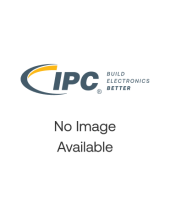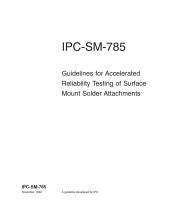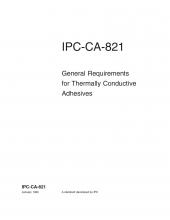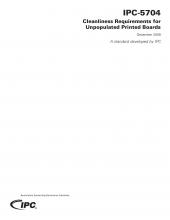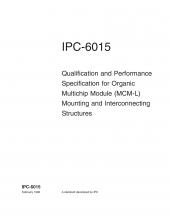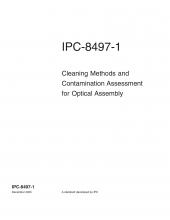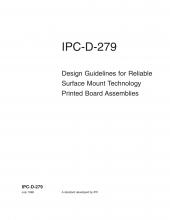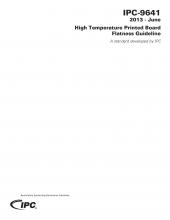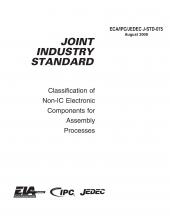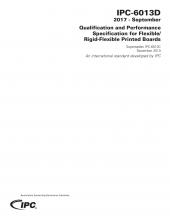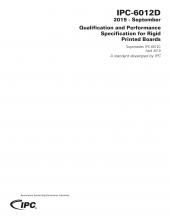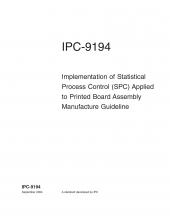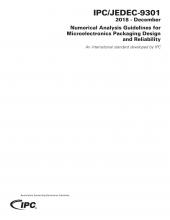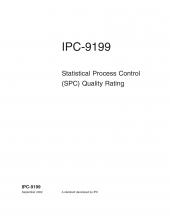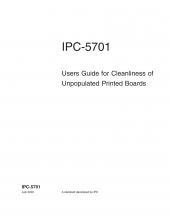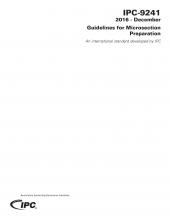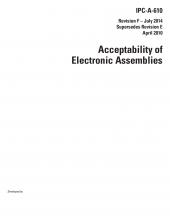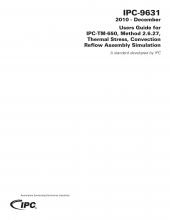Products
Contains over 150 industry approved test techniques and procedures for chemical, mechanical, electrical, and environmental tests on all forms of printed boards and connectors. New and updated test methods are available for download at https://www.ipc.org/test-methods.
Guidelines for accelerated reliability testing of surface mount solder attachments when evaluating and extrapolating the results of these tests towards actual use environments of electronic assemblies. 50 pages. Released November 1992.
Covers requirements and test methods for thermally conductive dielectric adhesives used to bond components in place. Permanent, removable and self-shimming adhesives are addressed. 18 pages. Released January 1995.
Printed board quality encompasses many parameters, cleanliness being one important parameter. This document defines the recommended general requirements for the cleanliness of unpopulated (bare) single, double-sided and multilayer printed boards. Coverage is given to Ion Chromatography (IC) testing and Ionic cleanliness testing for process control. 6 pages. Released December 2009.
Establishes the specific requirements for organic mounting structures used to interconnect chip components, which in combination form the completed functional organic single-chip module (SCM-L) or organic multichip module (MCM-L) assembly. Includes the quality and reliability assurance requirements that must be met for their acquisition. For use with IPC-6011. 25 pages. Released February 1998.
This standard describes the methods of inspecting and cleaning all optical interfaces so that interconnectivity integrity of the optical signal is maintained. The information provided focuses on techniques and methods to accomplish maximum quality of the interface and describes methods of contamination prevention. The target audience for this standard are Manufacturing Operators, Manufacturing...
Establishes design concepts, guidelines and procedures for reliable printed wiring assemblies. Focuses on SMT or mixed technology PWAs, specifically addressing the interconnect structure and the solder joint itself. Discusses substrates, components, attachment materials, coatings and assembly processes and testing considerations. In addition, this document contains detailed appendices covering...
Printed board flatness is largely affected by a change in intrinsic properties through exposure to variances in temperature. The worst case deviation of the printed board from flatness may be at room temperature, peak temperature during reflow, or at any temperature in between. Printed board flatness must therefore be characterized during the entire reflow thermal cycle, and not solely at room...
J-STD-075 picks up where J-STD-020 left off by providing test methods to classify worst-case thermal process limitations for electronic components. Classification is referenced to common industry wave and reflow solder profiles including lead-free processing. The classifications represent maximum process sensitivity levels and do not establish rework conditions or recommended processes for an...
The IPC-6013D covers qualification and performance requirements for flexible printed boards designed to IPC-2221 and IPC-2223. The flexible printed board may be single-sided, double-sided, multilayer or rigid-flex multilayer. All of these constructions may include stiffeners, PTHs, microvias, and blind/buried vias. IPC-6013D incorporates new and updated requirements for final finishes, rigid-to...
The European Union’s Restriction of Hazardous Substances (RoHS) legislation has had a profound impact on the electronics industry. One of the restricted substances, lead (Pb), is commonly used in alloys with tin for component finishes, printed board finishes and solders. Pb-free materials directly affect product performance, reliability and service life in many ways. There have been numerous...
This specification covers qualification and performance of rigid printed boards, including single-sided, double-sided, with or without plated-through holes, multilayer with or without blind/buried vias and metal core boards. It addresses final finish and surface plating coating requirements, conductors, holes/vias, frequency of acceptance testing and quality conformance as well as electrical...
This guideline standard is intended to aid in interpretation of the requirements in IPC-9191, "General Guidelines for Implementation of Statistical process Control," specifically for printed board assembly (PBA) manufacture. This document and IPC-9191 should be used together; the standards are cross-referenced to each other in the Appendices of this guideline. This standard promotes process...
The IPC/JEDEC-9301document is an effort to standardize and document some of the basic tenets of a typical Finite Element Analysis (FEA) model, as well as, to educate new designers (and in some cases even experienced designers) on the basic information and best practices that should be captured and provided to technical reviewers of the results of FEA data.
This document is a tool for a customer or supplier organization's internal audit group to assess a statistical process control (SPC) system against the requirements of IPC-9191. This document should be used by customers and suppliers of any size and for any commodity. This tool can be used to perform an assessment of the use of SPC at both organizational and process levels. The questions in this...
Tackling PCB cleanliness is a tough job; residues on printed circuit boards are directly related to the reliability of the produced hardware and can result in serious failures if not known or monitored. But how do you measure "cleanliness"? How clean is "clean"? The IPC-5701 provides guidance into how these issues should be approached and specified in purchasing documents, addressing levels of...
Discusses the many variables and problems associated with the process--from sample removal to micro-etch-- and the variables common to high volume microsection. The process variables and problems are organized so that the reader can research a specific issue or overview the variables of a process area. 31 pages. Released October 1993.
This standard is intended as a guideline in the proper preparation of a metallographic sample (microsection) of a printed board. The finished microsection is used for evaluating the quality of the laminate system and plated structures (e.g. PTHs and vias). Microsection sample preparation is regarded by many as a highly developed skill. The guidelines in this standard discuss the many variables and...
IPC-A-610 is the most widely used electronics assembly standard in the world. A must for all quality assurance and assembly departments, IPC-A-610E illustrates industry-accepted workmanship criteria for electronics assemblies through full-color photographs and illustrations. Topics include flex attachment, board in board, part on part, lead free, component orientation and soldering criteria for...
Provides information on multichip module technology, including parametric data, design and manufacturing information and a proposed categorization of various approaches to multichip interconnect substrate technologies based on dielectric family. 120 pages. Released August 1992.
IPC-A-610F Amendment 1 is now available. See Related items. IPC-A-610 is the most widely used electronics assembly standard in the world. A must for all quality assurance and assembly departments, IPC-A-610F illustrates industry-accepted workmanship criteria for electronics assemblies through detailed statements reflecting acceptable and defect conditions, supported by full-color photographs and...
IPC-9631 addresses concerns and considerations related to IPC-TM-650, Method 2.6.27, Thermal Stress, Convection Reflow Assembly Simulation. This document describes how the test method is intended for use and the rationale behind some of the protocols and requirements. This document was developed with the understanding that the test method will require special equipment and the proper set-up and...
Mechanical bend and shock tests are routinely performed on SMT assemblies to ensure that they can sustain anticipated production, handling and end use conditions. The strains and strain rates applied to SMT assemblies during bend and shock testing can lead to a variety of failure modes in the vicinity of the solder joints. This document provides test methods to evaluate the susceptibility of...
Provides information on design characteristics and the application of solderless surface mount connectors, including conductive adhesives to aid IC package and board interconnection. 34 pages. Released January 1994.
Establishes the requirements for the evaluation of liquid and dry film solder mask material and for the determination of the acceptability of use on a standard printed board system. IPC-SM-840 provides two classes of requirements, T and H, to reflect functional performance requirements and testing severity based on industry/end use requirements. Coverage is given to adhesion, material qualification...
Coming Soon
IPC-7095E: Design and Assembly Process Implementation for Ball Grid Arrays (BGAs)
IPC-7530B: Guidelines for Temperature Profiling for Mass Soldering Processes (Reflow & Wave)
IPC-2294: Design Standard for Printed Electronics on Rigid Substrates
IPC-6904: Qualification and Performance Specifications for Printed Electronics on Rigid Substrates
IPC-4105: Specification for Metal Base Copper Clad laminates for Rigid Printed Boards

